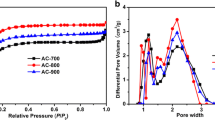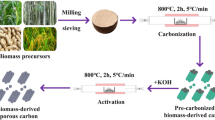Abstract
Areca palm leaves derived porous carbon material as the electrode for symmetrical solid-state supercapacitors (SSCs). The areca palm leaves biomass was processed using a fast carbonization method followed by in situ chemical activation. The structures and compositions of these biomass-derived carbon materials were characterized using X-ray diffraction, Raman spectroscopy, and X-ray photoelectron spectroscopy, respectively. One of the biomass-derived porous carbon materials, AR2, was a lightweight carbon material that possessed a large surface area of 876 m2 g–1. Electrochemical studies revealed that AR2 possessed a high specific capacitance of 262 F g–1 at a scan rate of 5 mV s–1. We fabricated symmetrical SSCs featuring these carbon material as major (80 wt%) components of the electrodes and poly(vinyl alcohol)–Li2SO4 as gel polymer electrolyte. The optimal supercapacitor (SAR2) involving AR2 exhibited a specific capacitance of 132 F g–1 at a current density of 0.5 A g–1 and an energy density of 10.3 W h kg–1 at a power density of 375 W kg–1, and durability of retaining 92% of its initial capacitance after 5000 cycles—performance that is the excellent values reported for devices featuring derived from biomass.









Similar content being viewed by others
References
Gao Z, Zhang Y, Song N, Li X (2017) Biomass-derived renewable carbon materials for electrochemical energy storage. Mater Res Lett 5(2):69–88
Wang J, Kaskel S (2012) KOH activation of carbon-based materials for energy storage. J Mater Chem 22:23710–32375
Candelaria SL, Shao Y, Li J, Cao G et al (2012) Nanostructured carbon for energy storage and conversion. Nano Energy 1:195–220
Pandolfo AG, Hollenkamp AF (2006) Carbon properties and their role in supercapacitor. J Power Sources 157:11–27
Hu B, Wang K, Wu L, Yu SH, Antonietti M, Titirici MM (2010) Engineering carbon materials from the hydrothermal carbonization process of biomass. Adv Mater 2:813–828
Bi Z, Chen CM et al (2019) Biomass-derived porous carbon materials with different dimensions for supercapacitor electrodes: a review. J Mater Chem A 7:16028–16045
Beguin F, Presser V, Balducci A, Frackowiak E (2014) Carbons and electrolytes for advanced supercapacitors. Adv Mater 26:2219–2251
Krishnamoorthy K, Sudhakaran MSP, Pazhamalai P, Mariappan VK, Mok YS, Kim SJ (2019) A highly efficient 2D siloxene coated Ni foam catalyst for methane dry reforming and an effective approach to recycle the spent catalyst for energy storage applications. J Mater Chem A 7:18950–18958
Liu X, Ma C, Li J, Zielinska B, Kalenczuk RJ, Chen X, Chu PK, Tang T, Mijowska E (2019) Biomass-derived robust three-dimensional porous carbon for high volumetric performance supercapacitors. J Power Sources 412:1–9
Natarajan S, Lee YS, Aravindan V (2019) Biomass-derived carbon materials as prospective electrodes for high-energy lithium- and sodium-ion capacitors. Chem Asian J 14:936–951
Huang SY, Le PA, Yen PJ, Lu YC, Sahoo SK, Cheng HW, Chiu PW, Tseng TY, Wei KH (2020) Cathodic plasma—induced syntheses of graphene nanosheet/MnO2/WO3 architectures and their use in supercapacitors. Manuscript ID: EA19-7871
Fic K, Platek A, Piwek J, Frackowiak E (2018) Sustainable materials for electrochemical capacitors. Mater Today 21:437–454
Dutta S, Bhaumik A, Wu KCW (2014) Hierarchically porous carbon derived from polymers and biomass: effect of interconnected pores on energy applications. Energy Environ Sci 7:3574–3592
Zhao HB, Yuan L, Fu ZB, Wang CY, Yang X, Yang X, Zhu JY, Qu J, Chen HB, Schiraldi DA (2016) Biomass-based mechanically strong and electrically conductive polymer aerogels and their application for supercapacitors. ACS Appl Mater Interfaces 8:9917–9924
Pang J, Zhang W, Zhang J, Cao G, Han M, Yang Y (2017) Facile and sustainable synthesis of sodium lignosulfonate derived hierarchical porous carbons for supercapacitors with high volumetric energy densities. Green Chem 19:3916–3926
Guan T, Li K, Zhao J, Zhao R, Zhang G, Zhang D, Wang J (2017) Template-free preparation of layer-stacked hierarchical porous carbons from coal tar pitch for high performance all-solid-state supercapacitors. J Mater Chem A 5:15869–15878
Li X, Liu K, Liu Z, Wang Z, Zhang D (2017) Hierarchical porous carbon from hazardous waste oily sludge for all-solid-state flexible supercapacitor. Electrochim Acta 240:43–52
Qiu D, Kang C, Gao A, Xie Z, Li Y, Li M, Wang F, Yang R (2019) Sustainable low-temperature activation to customize pore structure and heteroatoms of biomass-derived carbon enabling unprecedented durable supercapacitors. ACS Sustain Chem Eng 7:14629–14638
Huang Y, Peng L, Liu Y, Zhao G, Chen JY, Yu G (2016) Biobased nano porous active carbon fibers for high-performance supercapacitors. ACS Appl Mater Interfaces 8:15205–15215
Karnan M, Subramani K, Sudhan N, Ilayaraja N, Sathish M (2016) Aloe vera derived activated high-surface-area carbon for flexible and high-energy supercapacitors. ACS Appl Mater Interfaces 8:35191–35202
Li Y, Liu S, Liang Y, Xiao Y, Dong H, Zheng M, Hu H, Liu Y (2019) Bark-based 3D porous carbon nanosheet with ultrahigh surface area for high performance supercapacitor electrode material. ACS Sustain Chem Eng 7:13827–13835
Gong Y, Li D, Luo C, Fu Q, Pan C (2017) Highly porous graphitic biomass carbon as advanced electrode materials for supercapacitors. Green Chem 19:4132–4140
Zeng J, Wei L, Guo X (2017) Bio-inspired high-performance solid-state supercapacitors with the electrolyte, separator, binder and electrodes entirely from kelp. J Mater Chem A 5:25282–25292
Zhang Y, Liu L, Zhang P, Wang J, Xu M, Deng Q, Zeng Z, Deng S (2019) Ultra-high surface area and nitrogen-rich porous carbons prepared by a low-temperature activation method with superior gas selective adsorption and outstanding supercapacitance performance. Chem Eng J 355:309–319
Park JH, Rana HH, Lee JY, Park HS (2019) Renewable flexible supercapacitors based on all-lignin-based hydrogel electrolytes and nano fiber electrodes. J Mater Chem A 7:16962–16968
Sudhan N, Subramani K, Karnan M, Ilayaraja N, Sathish M (2017) Biomass-derived activated porous carbon from rice straw for a high-energy symmetric supercapacitor in aqueous and non-aqueous electrolytes. Energy Fuels 31:977–985
Liang Q, Ye L, Huang ZH, Xu Q, Bai Y, Kang F, Yang QH (2014) A honeycomb-like porous carbon derived from pomelo peel for use in high-performance supercapacitors. Nanoscale 6:13831–13837
Le PA, Nguyen VT, Yen PJ, Tseng TY, Wei KH (2019) A new redox phloroglucinol additive incorporated gel polymer electrolyte for flexible symmetrical solid-state supercapacitors. Sustain Energy Fuels 3:1536–1544
Dam DT, Wang X, Lee JM (2014) Graphene/NiO nanowires: controllable one-pot synthesis and enhanced pseudocapacitive behavior. ACS Appl Mater Interfaces 6:8246–8256
Ma G, Dong M, Sun K, Feng E, Peng H, Lei Z (2015) A redox mediator doped gel polymer as an electrolyte and separator for a high performance solid state supercapacitor. J Mater Chem A 3:4035–4041
Kumar N, Kumar A, Huang GM, Wu WW, Tseng TY (2018) Facile synthesis of mesoporous NiFe2O4/CNTs nanocomposite cathode material for high performance asymmetric pseudocapacitors. Appl Surf Sci 433:1100–1112
Hung CJ, Lin P, Tseng TY (2014) High energy density asymmetric pseudocapacitors fabricated by graphene/carbon nanotube/MnO2 plus carbon nanotubes nanocomposites electrode. J Power Sources 259:145–153
Song S, Ma F, Wu G, Ma D, Geng W, Wan J (2015) Facile self-templating large scale preparation of biomass-derived 3D hierarchical porous carbon for advanced supercapacitors. J Mater Chem A 3:18154–18162
Hui TS, Zaini MAA (2015) Potassium hydroxide activation of activated carbon: a commentary. Carbon Lett 16(4):275–280
Xie L, Chen CM et al (2016) Hierarchical porous carbon microtubes derived from willow catkins for supercapacitor applications. J Mater Chem A 4:1637–1646
Hao P, Liu H et al (2014) Hierarchical porous carbon aerogel derived from bagasse for high performance supercapacitor electrode. Nanoscale 6:12120–12129
Zequine C, Gupta RK et al (2017) High-performance flexible supercapacitors obtained via recycled jute: bio-waste to energy storage approach. Sci Rep 7:1174
Senthilkumar ST, Kalai Selvan R, Melo JS, Sanjeeviraja C (2013) High performance solid-state electric double layer capacitor from redox mediated gel polymer electrolyte and renewable tamarind fruit shell derived porous carbon. ACS Appl Mater Interfaces 5:10541–10550
Liu B, Zhang L, Qui P, Yu F et al (2016) Nitrogen-doped banana peel—derived porous carbon foam as binder-free electrode for supercapacitors. Nanomaterials 6(1):6010018
Wahid M, Puthusseri D, Phase D, Ogale S (2014) Enhanced capacitance retention in a supercapacitor made of carbon from sugarcane bagasse by hydrothermal pretreatment. Energy Fuels 28:4233–4240
Cheng P, Li T, Yu H, Zhi L, Liu Z, Lei Z (2016) Biomass-derived carbon fiber aerogel as a binder-free electrode for high-rate supercapacitors. J Phys Chem C 120:2079–2086
Ferrero GA, Fuertes AB, Sevilla M (2015) From soybean residue to advanced supercapacitors. Sci Rep 5:16618
Li X, Liu L, Wang X, Ok YS, Elliott JAW, Chang SX, Chung HJ (2017) Flexible and self-healing aqueous supercapacitors for low temperature applications: polyampholyte gel electrolytes with biochar electrodes. Sci Rep 7:1685
Gao Y, Yue Q, Gao B, Sun Y, Wang W, Li Q, Wang Y (2013) Comparisons of porous, surface chemistry and adsorption properties of carbon derived from Enteromorpha prolifera activated by H4P2O7 and KOH. Chem Eng J 232:582–590
Chen Q, Li X, Zang X, Zhu H et al (2014) Effect of different gel electrolytes on graphene-based solid-state supercapacitors. RSC Adv 4:36253–36256
Yang X, Zhang F, Zhang L, Zhang T, Huang Y, Chen Y (2013) A high-performance graphene oxide-doped ion gel as gel polymer electrolyte for all-solid-state supercapacitor applications. Adv Funct Mater 23:3353–3360
Huang CW, Wu CA, Hou SS, Kuo PL, Hsieh CT, Teng H (2012) Gel electrolyte derived from poly(ethylene glycol) blending poly(acrylonitrile) applicable to roll-to-roll assembly of electric double layer capacitor. Adv Funct Mater 22:4677–4685
Nguyen VT, Yang TY, Le PA, Yen PJ, Chueh YL, Wei KH (2019) New simultaneous exfoliation and doping process for generating MX2 nanosheets for electrocatalytic hydrogen evolution reaction. ACS Appl Mater Interfaces 11:14786–14795
Wang S, Gai L, Jiang H, Guo Z, Bai N, Zhou J (2015) Reduced graphene oxide grafted by the polymer of polybromopyrroles for nanocomposites with superior performance for supercapacitors. J Mater Chem A 3:21257–21268
Yen PJ, Ilango PR, Chiang YC, Wu CW, Hu YC, Chueh YL, Wei KH (2019) Tunable nitrogen-doped graphene sheets produced with in situ electrochemical cathodic plasma at room temperature for lithium-ion batteries. Mater Today Energy 12:336–347
Liu J, Deng Y, Li X, Wang L (2016) Promising nitrogen-rich porous carbons derived from one-step calcium chloride activation of biomass-based waste for high performance supercapacitors. ACS Sustain Chem Eng 4:177–187
Yen PJ, Sahoo SK, Chiang YC, Huang SY, Wu CW, Hsu YC, Wei KH (2019) Using different ions to tune graphene stack structures from sheet- to onion-like during plasma exfoliation, with supercapacitor applications. Nanoscale Res Lett 141:141
Winter M, Brodd RJ (2004) What are batteries, fuel cells, and supercapacitors? Chem Rev 104(10):4245–4270
Acknowledgements
K. H. Wei thanks the Center for Emergent Functional Matter Science of National Chiao Tung University [from the Featured Areas Research Center Program within the framework of the Higher Education Sprout Project by the Ministry of Education (MOE), Taiwan] and the Ministry of Science and Technology of Taiwan (MOST 106-2221-E-009-132-MY3) for financial support.
Author information
Authors and Affiliations
Contributions
Prof. KHW and Prof. TYT supervised the research project. All the experiments were designed and performed by PAL and he also wrote the manuscript. NVT, SKS helped to analyze structural measurement of biomass-derived carbon materials. All authors discussed and commented on the manuscript.
Corresponding authors
Ethics declarations
Conflict of interest
The authors declare that they have no known competing financial interests or personal relationships that could have appeared to influence the work reported in this paper.
Additional information
Publisher's Note
Springer Nature remains neutral with regard to jurisdictional claims in published maps and institutional affiliations.
Electronic supplementary material
Below is the link to the electronic supplementary material.
Supplementary file2 (MPG 18530 kb)
Supplementary file3 (MPG 5566 kb)
Supplementary file4 (MPG 8308 kb)
Rights and permissions
About this article
Cite this article
Le, PA., Nguyen, VT., Sahoo, S.K. et al. Porous carbon materials derived from areca palm leaves for high performance symmetrical solid-state supercapacitors. J Mater Sci 55, 10751–10764 (2020). https://doi.org/10.1007/s10853-020-04693-5
Received:
Accepted:
Published:
Issue Date:
DOI: https://doi.org/10.1007/s10853-020-04693-5




